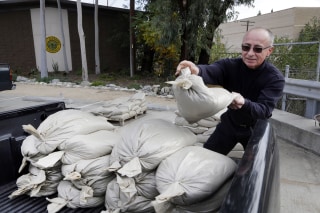El Nino has really hit the country hard this year. Here is a look at what it has done in California. We are always thinking of those impacted and we hope that everyone will stay safe in each storm that passes. How have the storms effected you?
Back-to-back storms in the Pacific are threatening to douse parts of the West for more than two weeks, thanks to a weather pattern driven by an El Niño that is tied with the strongest ever on record.
Storms drenched California Tuesday, with 1.42 inches of rain recorded at Los Angeles International Airport, breaking a daily record set in 1979, National Weather Service. Santa Monica got nearly 1.5 inches of rain and Malibu got 1.76 inches over the last 24 hours as of 4 p.m. local time (7 p.m. ET), the NWS said.
Two more storms are forecast for Wednesday and Thursday, and could bring as much as 3 inches of rain, causing The National Weather Service to issue a flash-flood watch for California.
A voluntary evacuation order was in place in the Silverado Canyon area of Orange County over mudslide fears, NBC Los Angeles reported.
Southbound lanes of U.S. Route 101 in Ventura County were closed due to “debris flow,” and a person was rescued by bystanders when a homeless encampment flooded in that county, the Ventura County Fire Department and police said.
In Los Angeles, the fire department rescued a dog that became trapped in high water in the West Hills. And in Arcadia, east of Los Angeles, a portion of a boulevard was closed after floodwaters spilled out onto the street.

El Niños are triggered when winds in the Pacific weaken or reverse direction, resulting in a warming of the ocean in the central and eastern Pacific, mainly along the equator. Clouds and storms follow the warm water, shifting jet streams and storm paths ss around the world.
They typically peak late in the year. The name “El Niño” (Spanish for “the boy,” or “Christ child”) was coined by Peruvian sailors, who were first to notice unseasonably warm water around Christmastime.
Last month, NASA experts warned the El Niño that had started wreaking havoc around the world in 2015 was only going to worsen in 2016, and said they feared it could get as bad as the 1997 El Niño, the most destructive one ever.

The National Oceanic and Atmospheric Administration said this week that the current El Niño has now tied the strongest previous El Niño on record — but it appears to have peaked, the agency added.
An El Niño’s strength is measured by sea-surface water temperatures in the Pacific, and from October through December 2015, water temperatures were 2.3 degrees Celsius above average, The Weather Channel reported. That ties the peak sea-surface temperature anomaly during the 1997-1998 El Niño.
Despite reaching its peak, El Niño is expected to impact California, along with the rest of the nation, in the coming weeks and months.
As much as 15 inches of rain could fall in the next 16 days in Northern California, with about 2 feet of snow forecast in the highest points of the Sierra Nevada, National Weather Service forecaster Johnny Powell told the Associated Press.
Meanwhile, in the southern part of the state, flash floods could affect Los Angeles County communities that experienced wildfires last summer and fall. The persistent wet conditions will put the areas at risk for mudslides.
A flash-flood watch for wildfire burn areas in Southern California was in effect through Wednesday. Between 2 and 3.5 inches of rain is predicted through Friday, with up to 5 inches in the mountains.
El Niño has already caused wild conditions for much of the United States in recent weeks. It contributed to a balmy Christmas Eve, along the East Coast, with temperature peaking in the 70s in places, and is partly responsible for deadly storms and near-record flooding in the South and Midwest.
While the wet weather could be a boon for California, which is currently in a historic drought, the constant rains could easily overwhelm the state.
“The fear is some of these storms come and you get too much at once, which could lead to flooding concerns,” Matt Sitkowski, a coordinating weather producer at The Weather Channel, told NBC News last week. “It doesn’t take much in parts of California.”
El Niños occur naturally every two to seven years. The December 1997 El Niño was blamed for extreme weather, including record rainfall in California and Peru, heat waves across Australia, and fires in Indonesia. The severe conditions resulted in an estimated 23,000 deaths in 1997 and 1998.
Originally Published with Photos: http://www.nbcnews.com/news/weather/string-storms-hitting-california-due-strongest-el-nino-record-n490506


